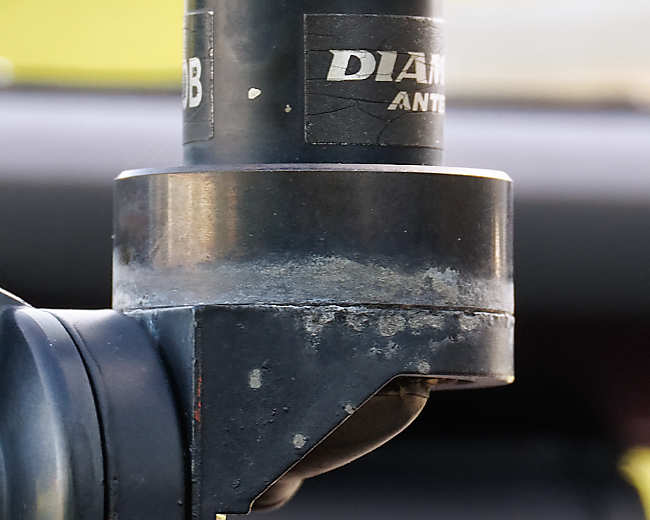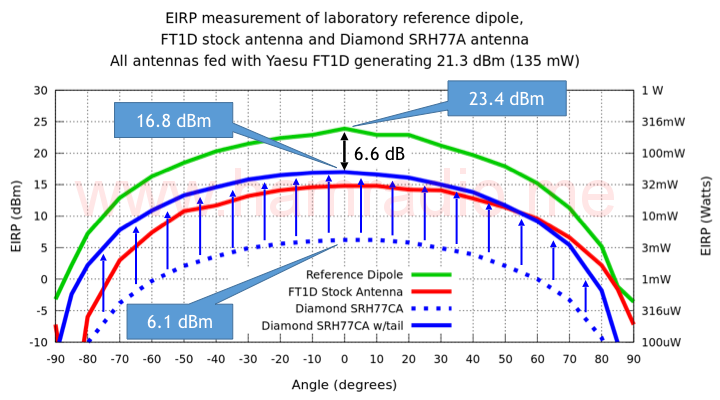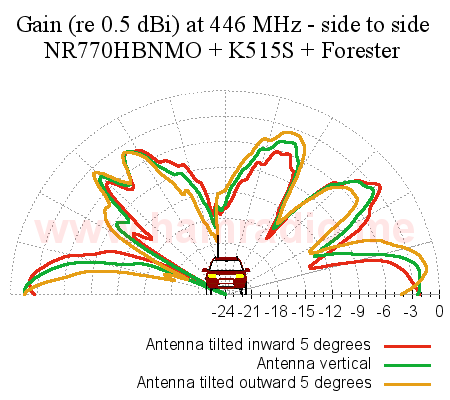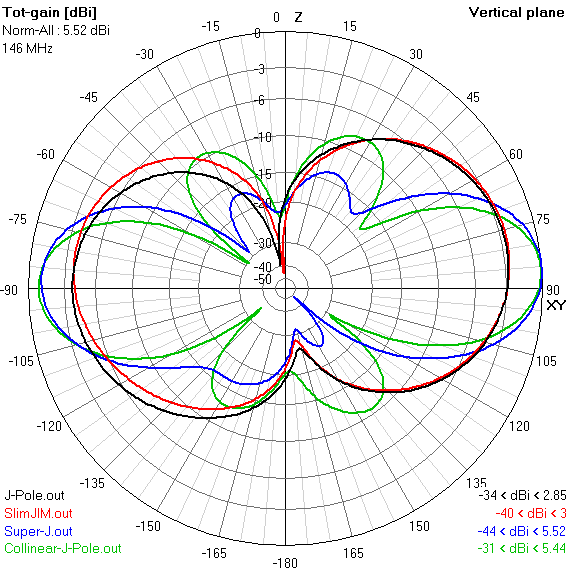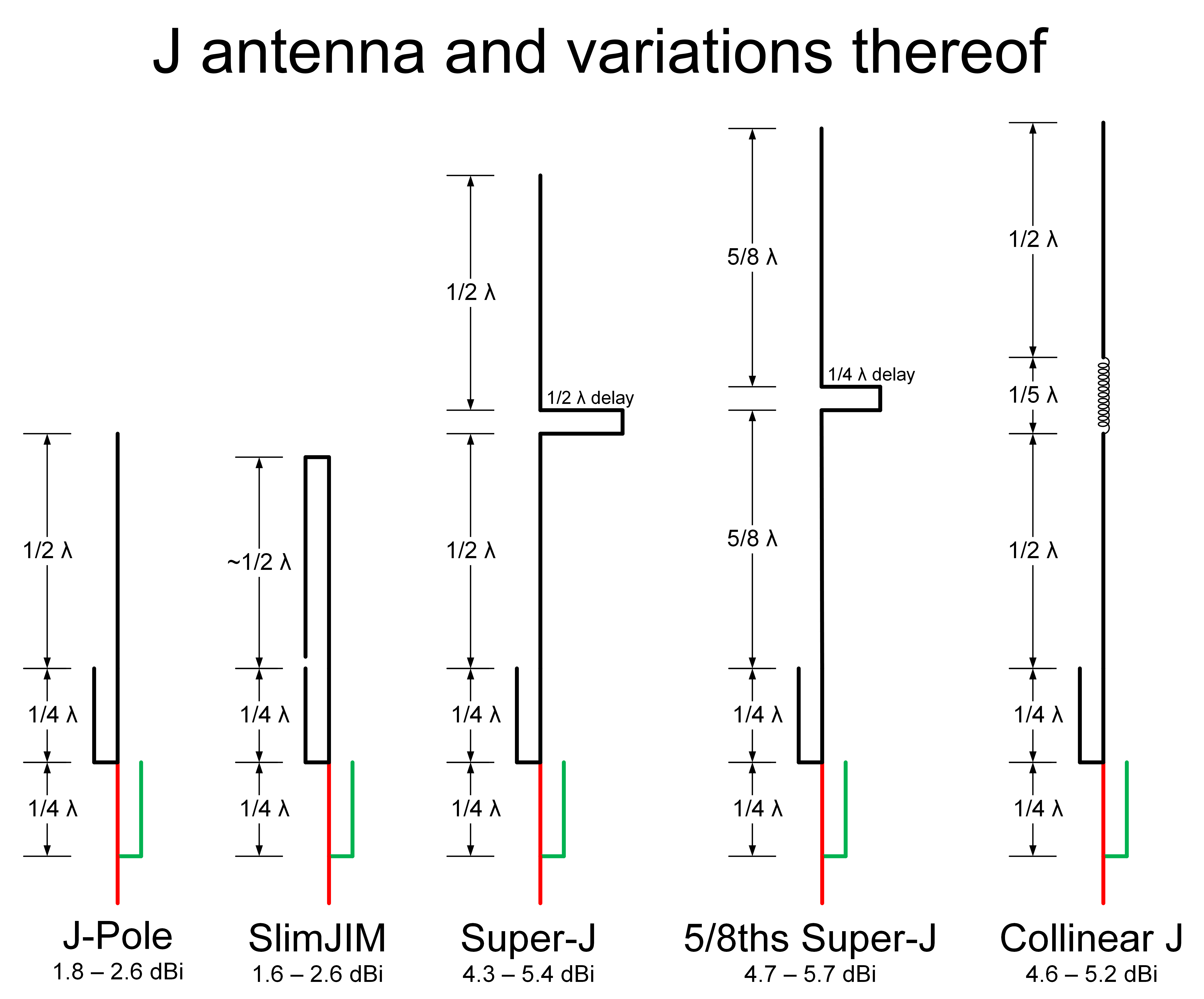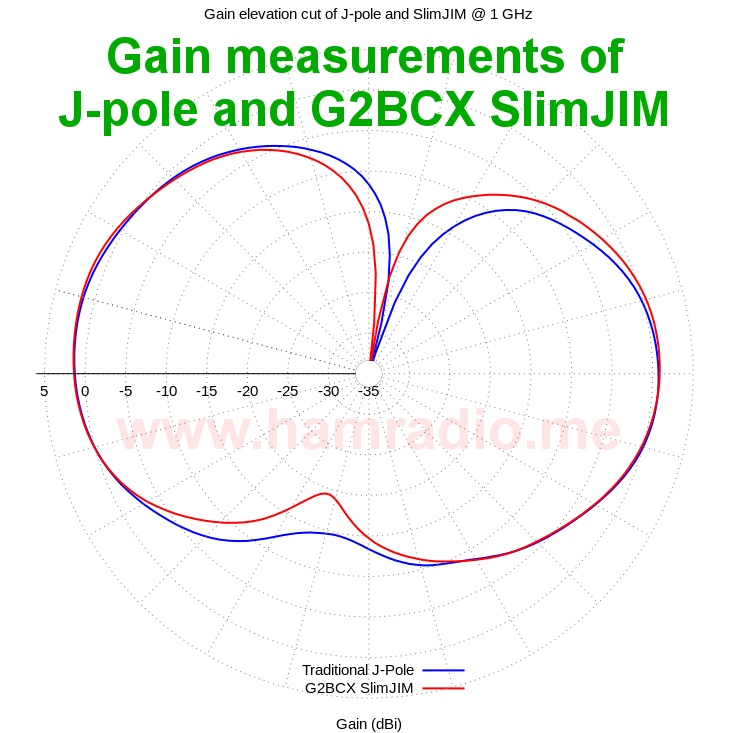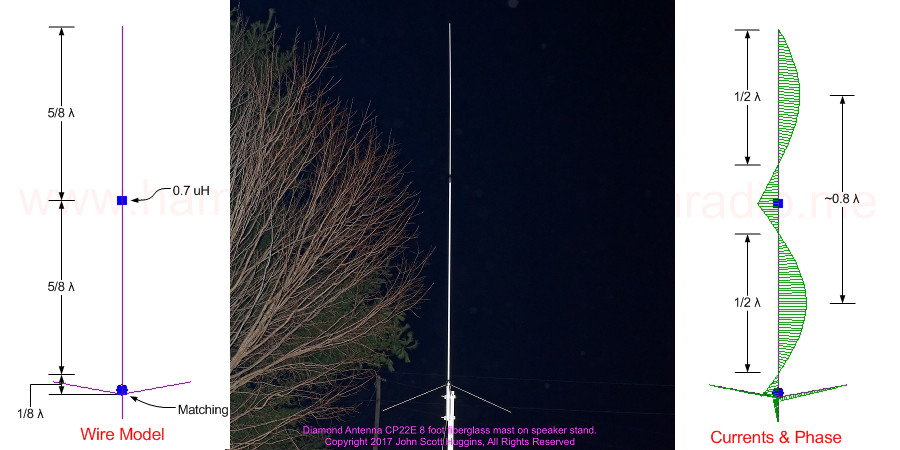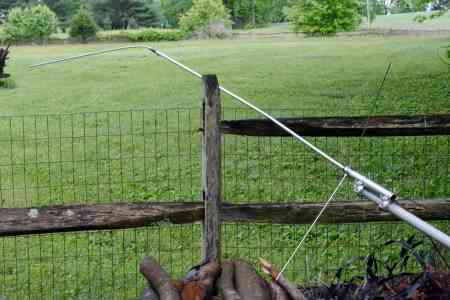Antenna gain in decibels
A relatively simple concept, antenna gain has proven to be problematic in certain circles of the radio world with a few distinct groups: antenna professionals, antenna aficionados and most everyone else. Everyone understands the general idea, but when decibels enter the picture we have trouble. The problem centers around the notion of what reference to use so that everyone is on the same channel. Fortunately the established antenna community has things well in hand. Let’s step our way though the topic and see what we can learn from the pros.
Antenna gain definition
I’ve gathered together some details discussing the definitions of Directivity and Gain and placed it in a new technical topic portion of this web site always available on the right sidebar…
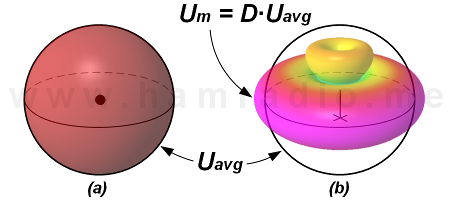
There is a difference between Directivity and Gain, but for the remainder of this article I will assume antenna efficiency is perfect and assume they are the same.
Isotropic reference
A key feature of the professional antenna community is the reliance on the isotropic radiator, itself based on the very definition of directivity [1], as the rock solid reference from which we measure all antennas. Looking at figure 1a above we see radiation of power equally in all directions. This is impossible to achieve with any practical antenna, but because it is based on a solid definition, it is unwavering as a reference. Figure 1b shows a Diamond CP22E antenna revealing how the power intensity is taken from some directions and added towards the waistline.
Linear gain math
One can easily get by handling antenna gain using only multiplication. For example the classic dipole has a gain factor of about 1.64 over an isotropic radiator with is gain factor of exactly 1.00. The Diamond CP22E of figure 1b has a gain factor of about 3.16 over an isotropic radiator. If you want to know the gain of the CP22E over a dipole you can simply divide one by the other…
Gain of Diamond CP22E over dipole = 3.16 / 1.64 = 1.93
…or about twice the power radiated towards the horizon.
The bel and decibel
In honor of Alexander Graham Bell, the unit bel represents the base 10 logarithm of a ratio between two power quantities of 10:1. There is a similar unit called the neper where one neper is the change in the level of a field quantity when the field quantity changes by a factor of e, that is 1 Np = ln(e) = 1. The shorthand identifier for bel and neper are B and Np respectively. The bel and neper have the following relationship…
One bel (B) is 1/2 ln(10) nepers : 1 B = 1/2 ln(10) Np
The bel is rather large in scope prompting the popularity of adding an SI prefix to create a smaller, more pragmatic unit. SI fractional prefixes include deci, centi, milli, micro, etc. making decibel, centibel, millibel, microbel, etc. all valid forms. One tenth was deemed a handy value in the 1930s so decibel has been the go to unit for logarithmic voltage and power gain representation since.[5]
1 bel = 10 decibels
The abbreviation for the decibel is…
- d = deci
- B = bel
- dB = decibel
The “d” is always lowercase. The “B” is always upper case.
Logarithmic gain math
The nature of the decibel is such that instead of multiplying linear values of gain you can, instead, add logarithmic values of gain. Let’s redo the above example.
One manifestation of the classic dipole antenna has a gain factor of about 1.64 (or 10*log(1.64/1) = 2.15 dB) over an isotropic radiator. The Diamond CP22E of figure 1b has a gain factor of about 3.16 (or 10*log(3.16/1) = 5dB) over an isotropic radiator. If you want to know the gain of the CP22E over a dipole you can simply divide subtract one by from the other…
Gain of Diamond CP22E over dipole = 5.00 dB – 2.15 dB = 2.85 dB
…or about twice the power radiated towards the horizon. Checking our math we can convert the 2.85 dB back to linear thus…
10^(2.85 dB/10) = 1.93
Linear and log – six one way, half-dozen the other.
dBi and dBd
The proper way to express decibel values in the International System of Units (SI) units is…
Gain of dipole = 2.14 dB (re isotropic) [2]
…or for those looking to pad their documentation with lots of words…
Gain of dipole with respect to an isotropic antenna = 2.14 dB [2]
Thankfully the professional antenna field coined the abbreviation dBi by at least 1968 [3] legitimizing the shorthand expression…
Gain of dipole = 2.14 dBi
For cases where one desires to compare gain to a dipole instead of the isotropic radiator, the proper expression will be…
Gain of dipole = 0 dB (re dipole) = 0 dBd
…where dBd is another well known shorthand notation for gain with respect to a dipole.
Note the reference dipole is always about 2.14 dB higher (or exactly 2.15 dB higher if you are the FCC [4]) than isotropic so the two are merely a constant value from each other… always.
In the antenna community, dBi and dBd mean nothing else!
Gain pain – alternative expressions for dBd?!?!?!
Chillingly many folks (hams mostly) believe dBd has alternative definitions where, for example, an antenna is above ground. Nothing in professional antenna engineering circles suggest that. While it is true comparing and contrasting antenna gains over ground makes some sense, this doesn’t give anyone carte blanche to rewrite the dictionary. Changing terminology due to misunderstanding is careless at best and possibly fraudulent at worst.
During a particular Zed Thread the commentary drifted into an alt meaning of dBd suggesting a dipole over ground was an alternative baseline reference used by professional antenna manufacturers. When challenged to show one example, the poster suggested this impressive 20m beam from M2. Let’s examine the specs from their web site…
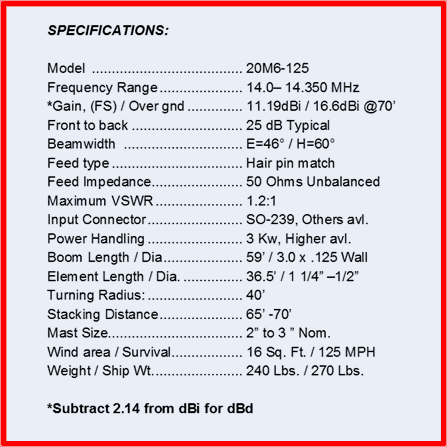
Examining the M2 20M6125 specifications
It’s clear from the specs…
- Gain (Freespace) = 11.19 dBi ~ 9 dBd
- Gain (70′ AGL) = 16.6 dBi ~ 14.5 dBd
Another more SI compliant way to put this is…
- Gain = 11.19 dBi ~ 9 dBd (based on the standard definition of Directivity/Gain)
- Gain (70′ AGL) = 16.6 dB (re isotropic) ~ 14.5 dB (re isotropic dipole)
M2 never redefines the isotropic meaning of dBi or its derivative dBd as the poster suggests. M2 has carefully prepared their data to be non-ambiguous so it can pass the smell test of the antenna engineering world. What’s missing, of course, are the characteristics of the ground. To be above board that really should be part of this data, but hey… an A for effort.
So… M2 verifies for us they see dBi and dBd as both referencing isotropic circumstances, as used by those in the professional antenna community. They make crystal clear where they deviate from these measurement constants. If they did not, they would eventually be flagged for erroneous specifications by purchasing agents in the know. This could become a serious embarrassment especially if they sell to government and corporate customers… which seems likely given their stature in the antenna biz.
M2 correctly avoids using erroneous sammy the hammy antenna jargon – they know better. I suspect other major players in the antenna biz do so as well.
My antenna has x dB gain – oh no!
In a post like this we can’t pass up the golden opportunity to highlight the less knowledgeable antenna manufacturers touting mystical properties of their antenna’s gain performance. One dead giveaway is stating antenna gain with no implied reference at all such as…
- SlimJim J antenna with ‘6db of gain’ – This is actually a fine 2-3 dBi antenna, but certainly not 6 dB anything;
- Copper SlimJim antenna with ‘Gain: 6 dbi’ – They try to pass the idea a 2-3 dBi antenna has twice the gain than is possible. False advertising? Perhaps they don’t quite understand how SlimJims work? You be the judge.
Keeping in mind the relationship between dBi and dBd is a mostly constant value of 2.14-2.15 dB, read this…
-
Low Power FM (LPFM) Broadcast Antenna – with a gain claim of “3 dbi (2.5 dbd)” – You do the math and evaluate the antenna knowledge of the author.
The lowercase b in db says something about the authors as well.
Diamond Antenna does it too
Some notable companies in the antenna biz fall short of “truth in advertising.” Diamond Antenna is, sadly, one such example. Their CP22E dual collinear 2m antenna is actually a very fine piece of engineering. I have researched this model plenty, own two, and is why I use it as a reference in figure 1. One hard rule about obtaining gain is the need to increase the antenna capture area. Two elements arranged collinearly and fed in phase can approximately double your effective gain – two times the power or 3 dB over a dipole. Four elements can double this again – four times the power or 6 dB over a dipole. Let’s check the CP22E manual description section…

Wow 6.5 dB gain over a dipole… something not even possible with four collinear elements let alone the two in this design. In reality the CP22E achieves about 2.85 dB over a dipole or about 5 dBi gain. This antenna is a very capable performer, approaches the theoretical two-collinear-element 3 dB improvement over a dipole and does so at a very good price. However, those who generate the documentation at Diamond Antenna have totally jumped the shark in the sad attempt at gainflation.
Grammar police?
Yes I admit to being an antenna jargon purist, but am making it clear the above issues reveal some serious lack of knowledge of folks claiming to be in the antenna manufacturing business. They need to step up their game before someone, perhaps from the FTC, calls their hand.
Conclusion
Half-baked understanding of any discipline is not a sin. We all were beginners once and had to learn. The learning never really ends, but some appear to reach a point of understanding and then the locomotive of their education train stops with a loud bang. Thereafter they base life’s decisions on truncated knowledge. The defending of dBd as non-isotropic using backfiring evidence from M2 was humorous. Hammy antenna manufacturers too often blow smoke you know where in some of their product specifications. When hams or any antenna makers contradict the first 30-50 pages of ANY college level antenna book, be very afraid.
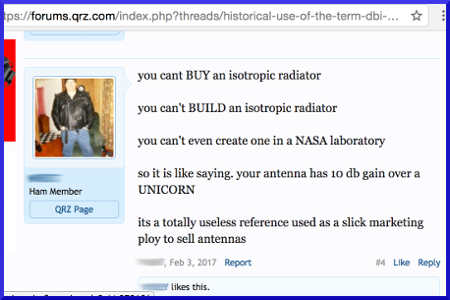
References
- Cheng, David K. (1983). Field and Wave Electromagnetics. Addison-Wesley Publishing Company.
- Thompson Ambler; Barry N. Taylor (2008). Guide for the Use of the International System of Units (SI) – NIST Special Publication 811. National Institute of Standards and Technology
- Ralph W Campbell. Patent US3491361A.
- 412172 Determining ERP and ERIP, FCC.
- William H. Harrison (1931). “Standards for Transmission of Speech”. Standards Yearbook. National Bureau of Standards, U. S. Govt. Printing Office.
